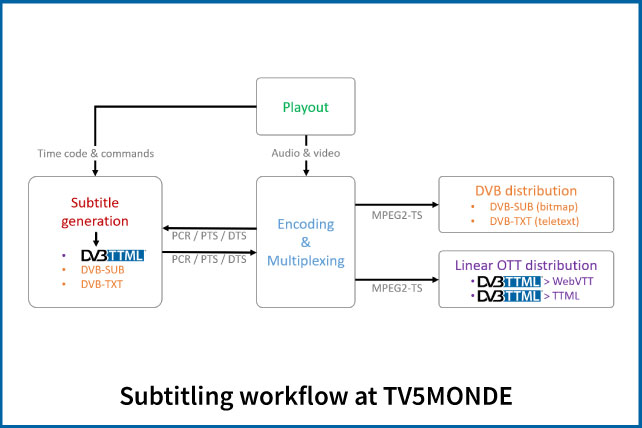Sébastien Bogaert (TV5MONDE)
Available in 198 countries and in 421 million households, TV5MONDE is one of the world’s largest television networks. The mission of this francophone service is to promote French speaking worldwide. It does this through eight general entertainment channels, two thematic channels – kids and lifestyle – and the on-demand platform TV5MONDEplus.
Since April 2021, TV5MONDE has been using DVB-TTML as a pivot subtitling format between playout and packaging.
For learners, subtitles are a crucial tool. They are provided in 13 languages. Providing subtitles on broadcast services – satellite, cable or terrestrial – for TV sets and set-top boxes, is straightforward, being either teletext-based (DVB-TXT) or using bitmaps (DVB-SUB). For video-on-demand services, subtitles are provided using either WebVTT (web video text tracks) or TTML (timed text markup language) flat files.
Seeking a solution
For linear OTT, however, we struggled to identify solutions that could produce packaged WebVTT and TTML streams, in 13 languages, all synced with the linear broadcast playout. We initially tested an approach that would use optical character recognition (OCR) on DVB-SUB bitmap files, but had only limited success with some non-latin alphabets.
The appearance of DVB-TTML, in mid-2018, seemed to offer hope as a relevant format but there was no solution on the market. Some vendors were implementing DVB-TTML at inputs, but none was able to generate it as a source stream.
When we started the process of renewing our live streaming platforms – OTT packaging and origination – in 2020, we pushed the market by introducing DVB-TTML as a requirement in the specifications of our public tender. The winning submission came from Harmonic with its VOS®360 video SaaS platform. Harmonic worked with BroadStream Solutions to adapt their subtitling solution for the provision of DVB-TTML.
Since April 2021, TV5MONDE has been using DVB-TTML as a pivot format between playout and packaging. Our multiplexers expected specific data chains to fit the PMT (programme map table) descriptors, but video service manager tools were not ready ‘out of the box’ for describing DVB-TTML.
We worked it out by using sample streams available from the DVB website, successfully determining the expected values for the descriptor_tag, descriptor_tag_extension and subtitle_ purpose. Then we translated them into relevant raw data for our multiplexing equipment to fill in the DVB-SI tables.
Naturally we relied on the DVB-TTML standard itself (ETSI EN 303 560), but also some tables in DVB-SI (Specification for Service Information in DVB systems, EN 300 468).
Challenges remain
We continue to face some challenges, such as identifying up-to-date TR 101 209 (DVB Measurement) probing tools, offering proper DVB-TTML table decoding and analysis. With regard to monitoring, aside from our own web players and the OTT subtitle fragments produced (TTML, WebVTT), we are working on the development of a viewer in collaboration with EDRIS, a French software provider.
As a next step, we are currently studying implementing SMPTE ST 2110-43 in our core playout infrastructure, so that native DVB- TTML is generated upstream.
For the time being, DVB-TTML is distributed out of TV5MONDE only for OTT. However, it could be an attractive option on satellite and cable distribution, as there are real bandwidth savings: a single DVB-TTML track is typically less than 14 kbps compared to 128 or 200 kbps with bitmap subtitles, but this will depend on market readiness (STB vendors).
Sébastien Bogaert is Head of the Network Operations Centre and of Distribution for TV5MONDE. He led the project to implement DVB-TTML with Harmonic and BroadStream Solutions.
This article first appeared in issue 61 of DVB Scene magazine.


